1lumen selects and reviews products personally. We may earn affiliate commissions through our links, which help support our testing.
Acebeam Rider RX review
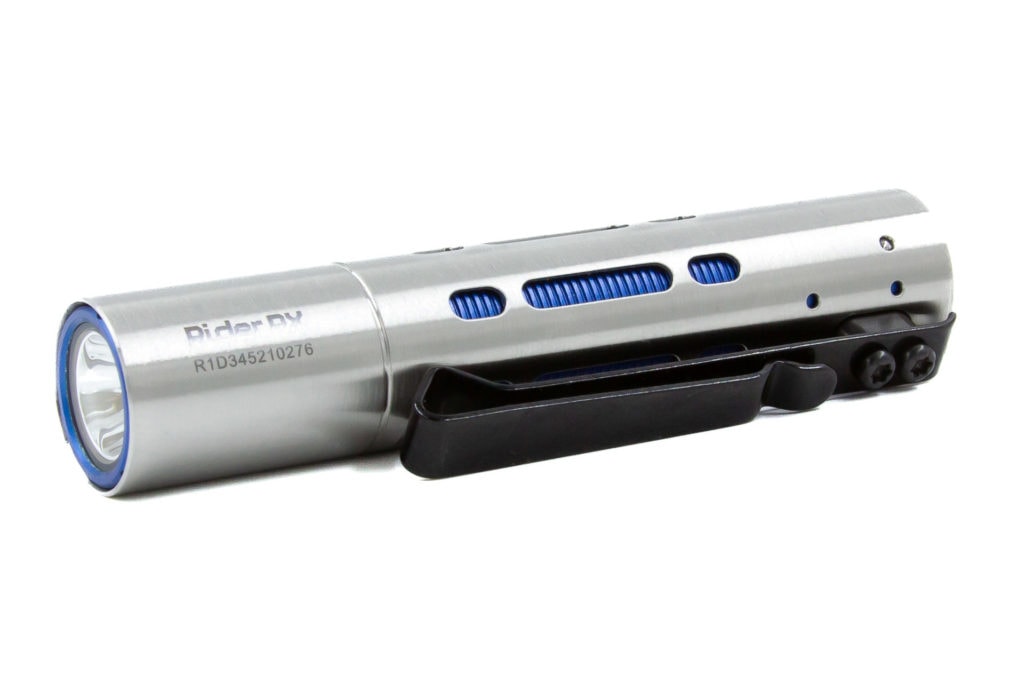
Acebeam Rider RX specifications
| Brand/model | Acebeam Rider RX |
|---|---|
| Category | EDC flashlight |
| LED | Nichia 219F |
| Max. Lumens | 650 lm |
| Max. Beam intensity / distance | 2304 cd |
| Battery config. | 14500/AA |
| Onboard charging | No, but built into battery |
| Modes | 4 |
| Blinkies | SOS |
| Reflector | Smooth |
| Waterproof | IP68 |
| Review date | March 2022 |
Introduction:
Acebeam is a company that needs no introduction to most flashlight enthusiasts. Founded in 2010, they’ve gone from strength to strength, releasing both high-powered lights for various tasks, as well as smaller EDC lights to fill that niche. This is one of the latter.
There’s two “firsts” (in my opinion) that I’m particularly interested in – it’s the first light I’ve seen with the Nichia 219F, and while it’s slightly cooler than my preferred colour temperature at 5000K, it’s still perfectly acceptable.
Secondly is the “fidget” aspect of it. The Rider RX is being marketed as having a clip that doubles as a fidget tool. While some may see this as somewhat of a gimmick, there are those out there with Autism or ADHD that may find this quite calming, and as a way to have something stable in an overly stimulating environment. As someone with ADHD myself, I’m keen to see how this plays out.
Let’s do this!
ADDENDUM: I just want to add this to the intro because it’s important to me. Midway through testing the light, I attempted to put the head of the light onto bench power to test current and LVP, and while dialling down the voltage from the 12V that I was previously using for another project to 4.2V for this, I must have not pressed the Enter button correctly, and have then dumped 12V into the driver. Needless to say, it has not come back to life after that.
Acebeam said they would send a replacement head for me to continue testing, but they sent an entire new light – I do want to thank them for helping me out when it was my own stupidity that got me in that situation in the first place.
Package quality.
I don’t normally expect smaller EDC lights to come in larger boxes, and this didn’t change my expectations. The box measures 121 x 38 x 27mm, so it’s nice and small – but still large enough to hold everything neatly. The box has an interesting texture which I found very difficult to photograph, but still – a nice added touch!
Inside the box, we find:
- The Acebeam Rider RX itself, with:
- An Acebeam 920mAh USB-C rechargeable 14500 cell inside (complete with isolator)
- A plastic peel-off layer over the lens to protect it
Tucked in behind the plastic shelf is:
- An Acebeam branded lanyard
- User manual
- O-rings in a bag
- USB-C to USB-A cable
Like a lot of lights lately, the Rider RX comes with everything needed to get up and running with the light out of the box.
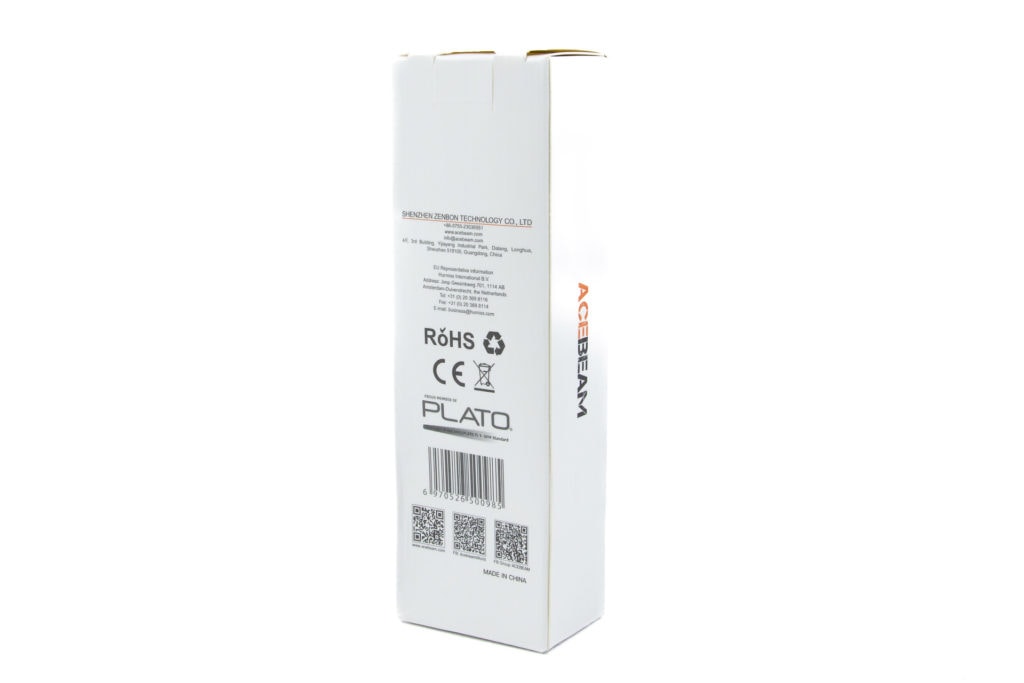
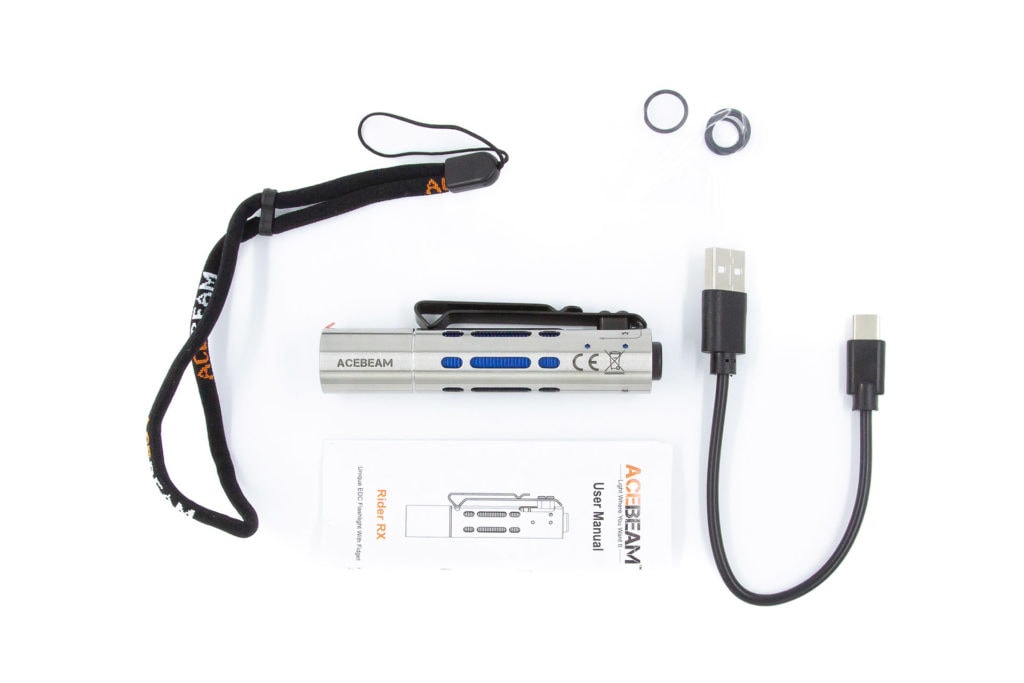
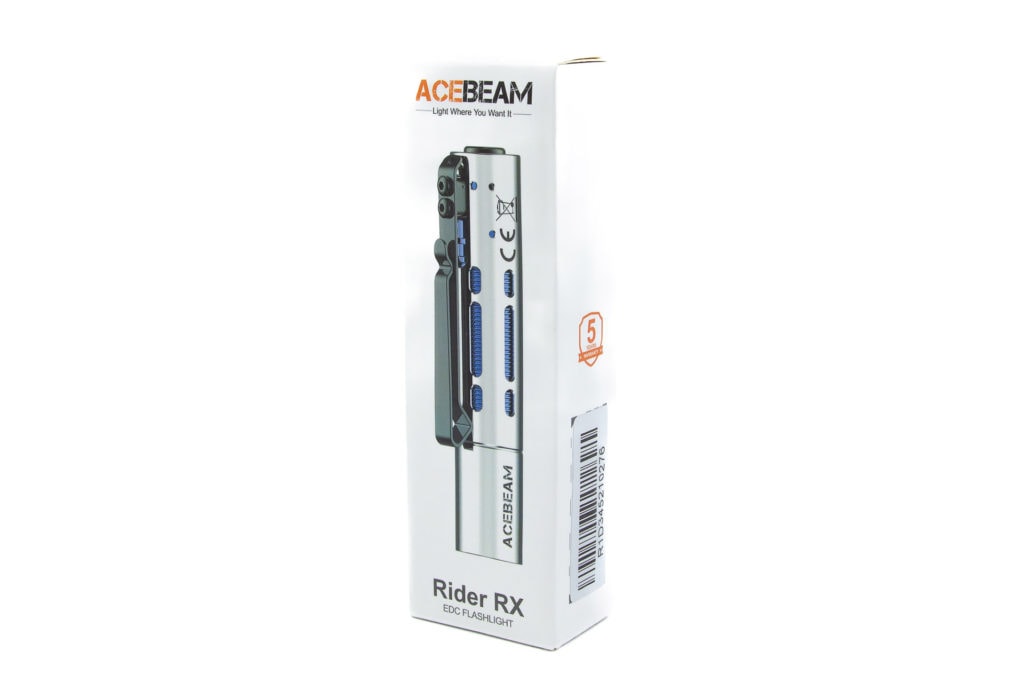
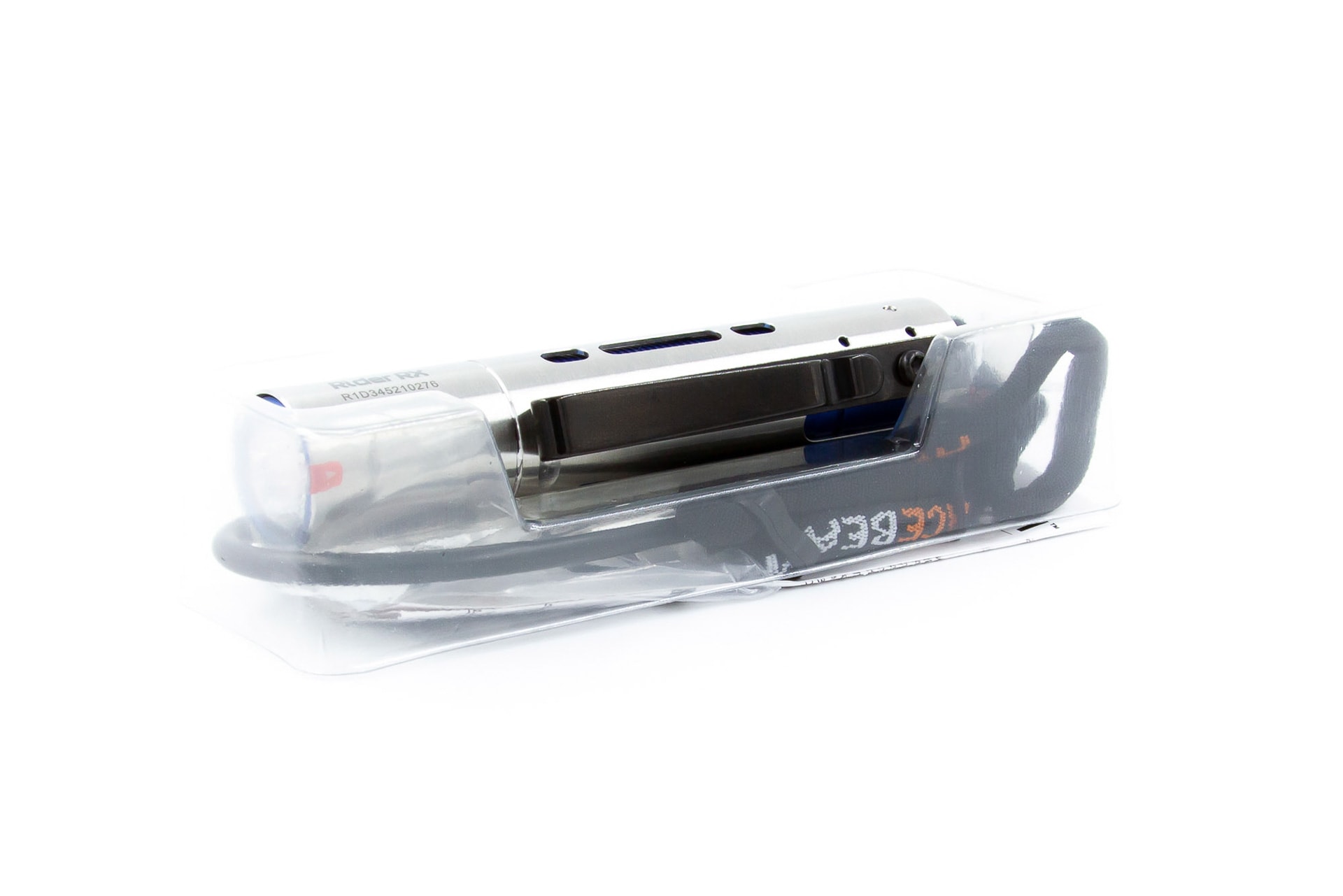
Flashlight in use
The Rider RX comes with a forward-clicky switch, giving momentary-mode support. Personally, I would have preferred a reverse-clicky, but I know that’s a matter of preference.
Inherently, the light is very smooth to hold, with the cutouts where the inner tube shows providing a bit of grip. The clip provides most of the grip by nature of it standing out, and being a double-back clip, having extra to hold onto.
It can be held either in a tactical grip or under-handed, but for anything more than a brief moment, I feel the under-handed method is far more comfortable. It’s not heavy enough to cause any kind of strain injury in a tactical grip, but I’m not getting any younger… injuries just seem to materialise out of thin air.
Tail-standing is done by engaging the clip – I’ll go over in more detail below, as it’s part of the “fidget” function. Briefly though, when the clip is in its lower position, the switch retracts within the outer body, and the light can tail-stand neatly.
A lanyard is included, but in a light like this, I don’t really see the point. It’s a good size lanyard, but that means it’s longer than the actual light, and looks a little silly. Don’t get me wrong – I love that it’s included, and it’s a great lanyard, but I don’t think I’ll be using it with this light. I’ve got sets of keys that it’ll look fantastic on, though.
~~~
And now the part I want to go over the most – the clip. Sure, it’s quite large, but that’s needed for the fidget portion of the product. Before I get into the details of it, take note of the three “dots” on the light in the image below; these are points where a ball-bearing or similar sit against the outer shell to provide stopping points.
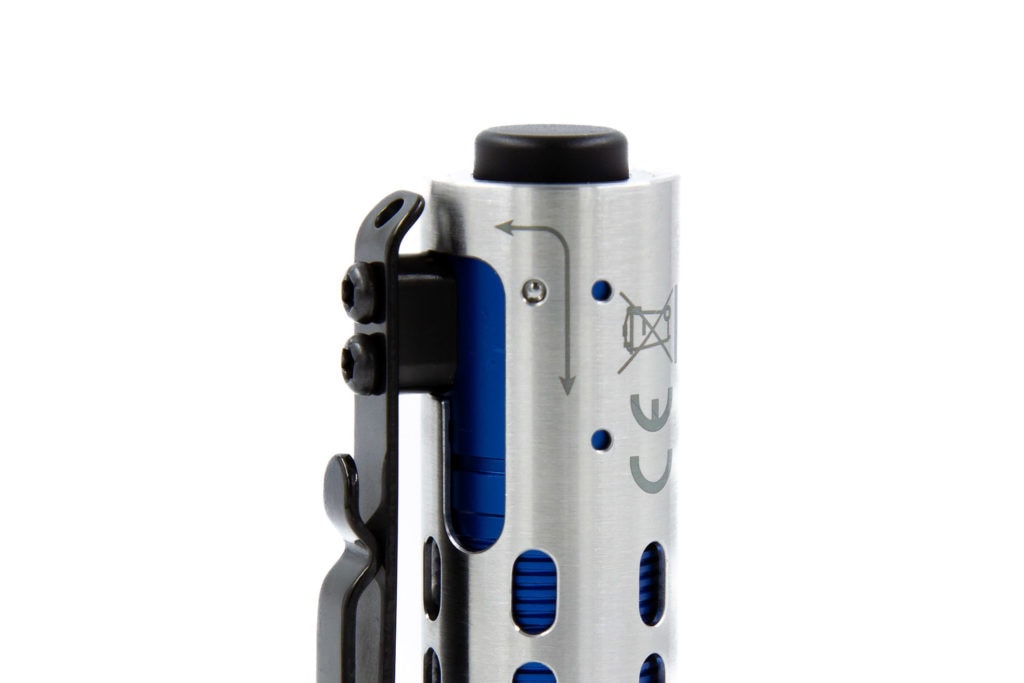
The clip can move in a path as shown by the arrow, and by the cutout of the outer shell.
Sliding the clip to the right moves the inner tube around (or, conversely, the outer shell around). The small bearings will come to rest in the next “point”. Sliding the clip down then exposes the head of the light, which is needed to unscrew the head to swap the battery out.
This movement is harder as the clip then needs to jump out of its “groove”, and move along the side of the light. Pushing the clip back upwards is harder, and for me, requires rotating the light and pushing back against the clip that way to retract the head of the light, as there’s not quite enough to “grab” when pushing back upwards.
The “fidget” part is therefore best left to just back and forth on the “left and right” motion – but it’s very satisfying. A very solid click in place, but note that it’s quite loud, and might annoy others. Acebeam have mentioned this will loosen up over time, so I’m going to spend a bit more time annoying my family with it. You know, for science.
Build Quality, and Warranty
Hooooo boy. The build quality on this is impeccable. The stainless steel outer shroud has a brushed look, which feels high-quality. The inner tube anodisation is a satin blue, and I can’t spot any defects on it – again, lovely.
In terms of grip, your fingers are most likely to grab onto the grooves cut into the stainless steel, or onto the clip. There’s no practical knurling on the outside, but I’ve not found myself fumbling with it.
As always, the included lanyard is great. I really need to make a spreadsheet somewhere of manufacturers with good lanyards, and then buy a bunch of them, as they always come in handy for other things, like small sets of keys. The USB cable, while short, does the job more than adequately.
Acebeam warrants their products with a pretty solid warranty – if there’s any problems within 15 days of purchase, the dealer is to replace the product. If it fails during normal use within 5 years, the dealer will repair or replace the light with the same or similar model.
After that, the dealer will attempt to repair the flashlight for the cost of parts and shipping, but no labour cost.
That said, the battery only has a 12 month warranty – but that’s still pretty good.
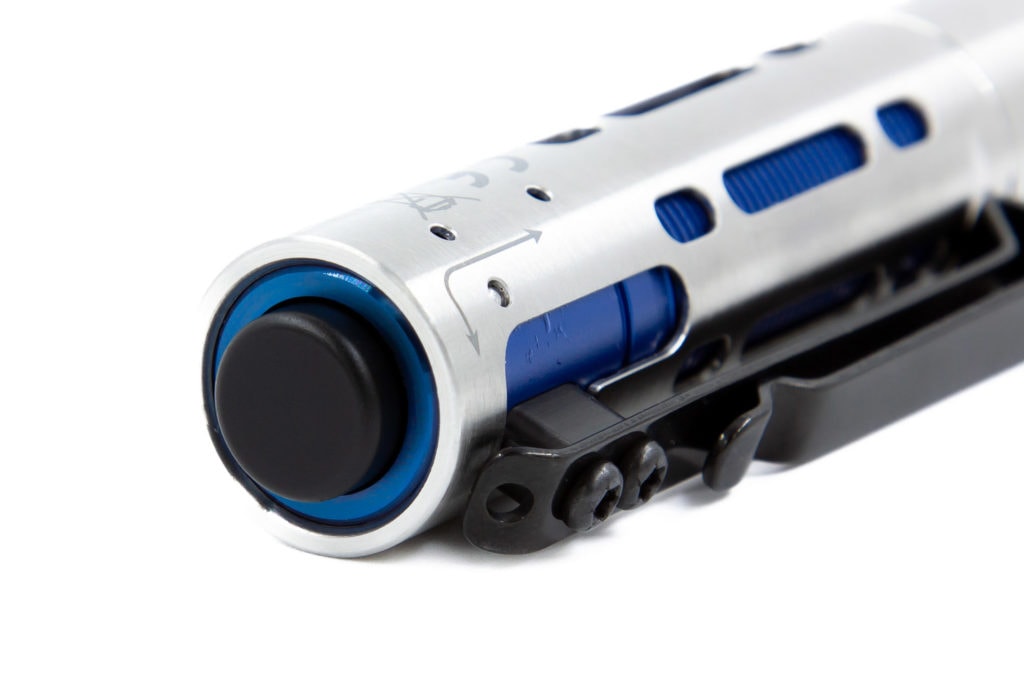
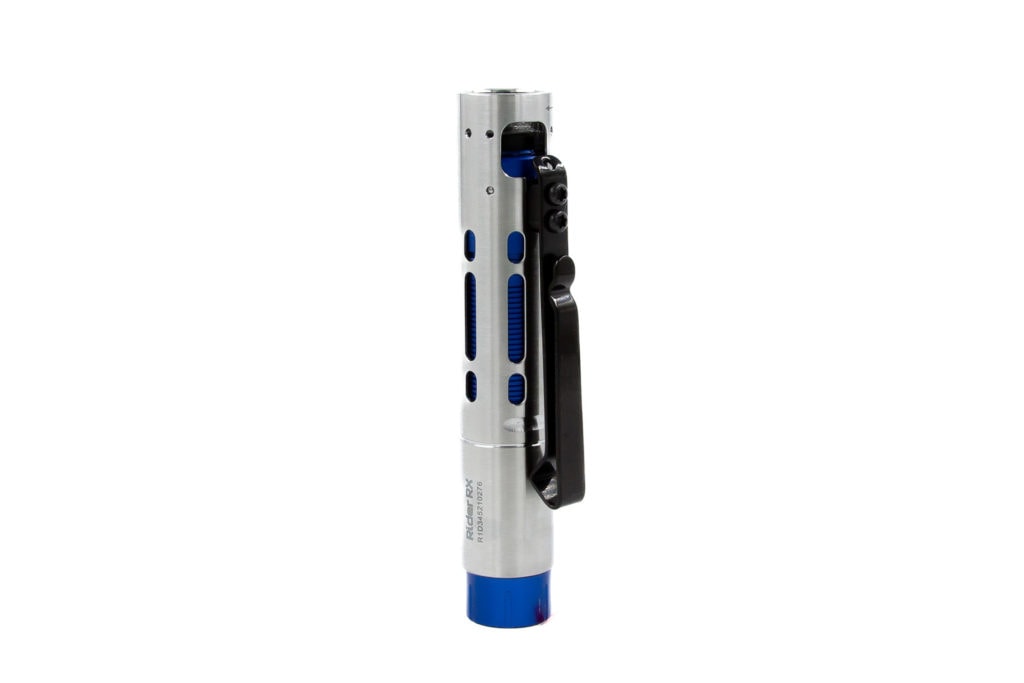
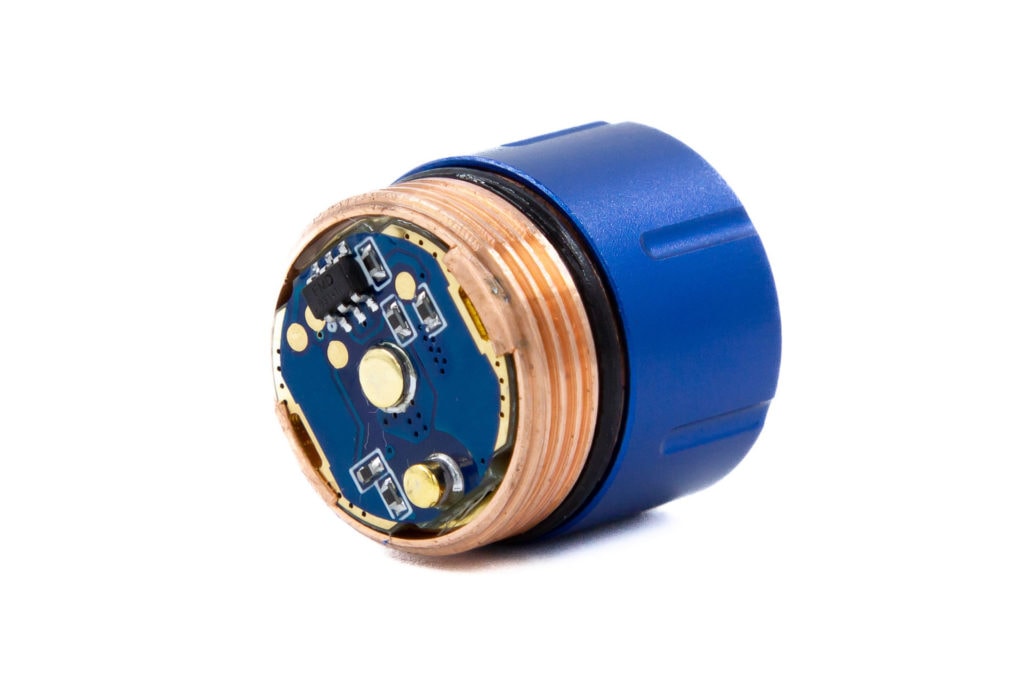
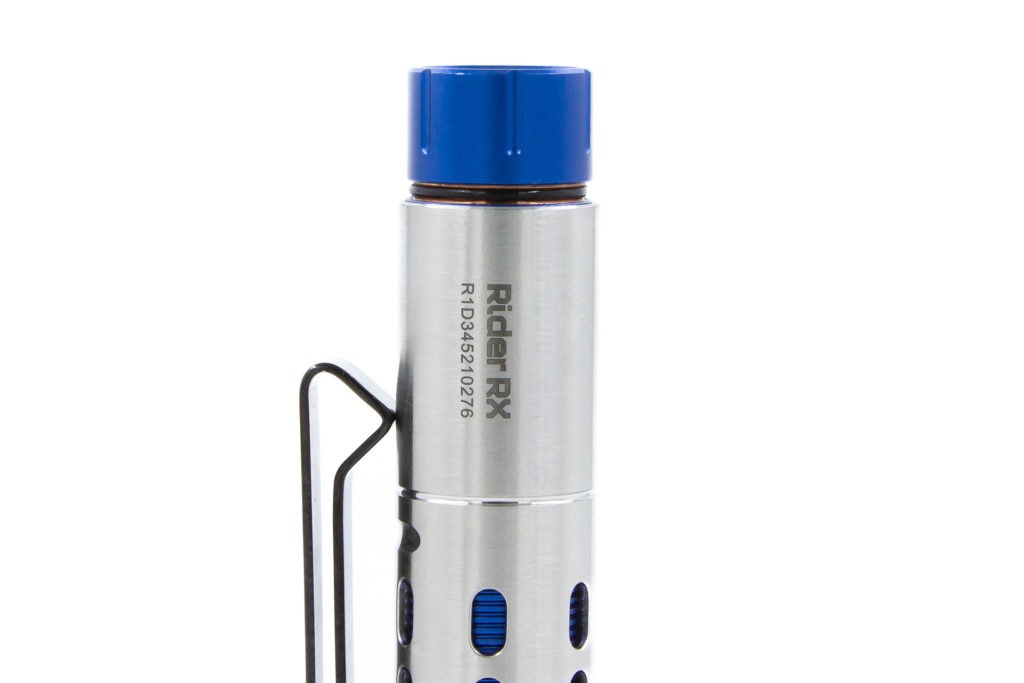

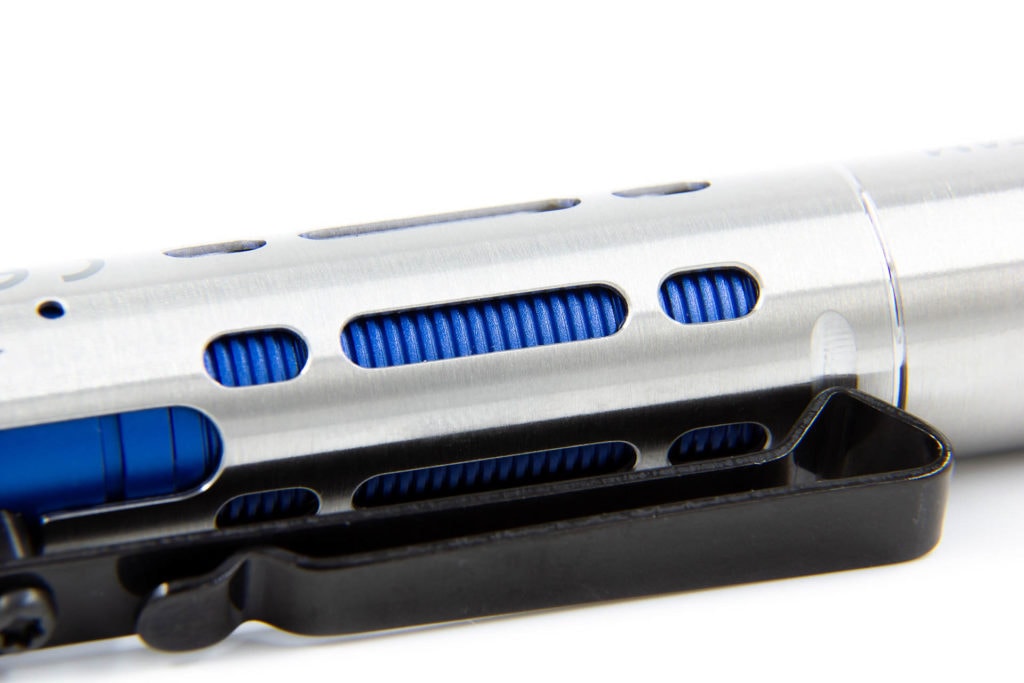
LED, Lens, Bezel, Beam, and Reflector
As mentioned above, the Rider RX is, to the best of my knowledge, the first production light to come with the Nichia 219F. The variant chosen is a 5000K 90CRI emitter, giving good colour rendering. Surrounding it is a smooth reflector, giving a nice beam profile. The reflector itself is fairly shallow though, so the beam ends up being a little more floody.
The bezel is smooth around the edge, with small indentations to provide some grip while unscrewing it to replace the battery.
Below are readings taken in each of the modes on my Xerox Phasermeter (Colormunki). As seen, CRI is at 89 in all modes but Ultralow where I measured 90, but that 1 CRI difference should be almost unnoticeable.
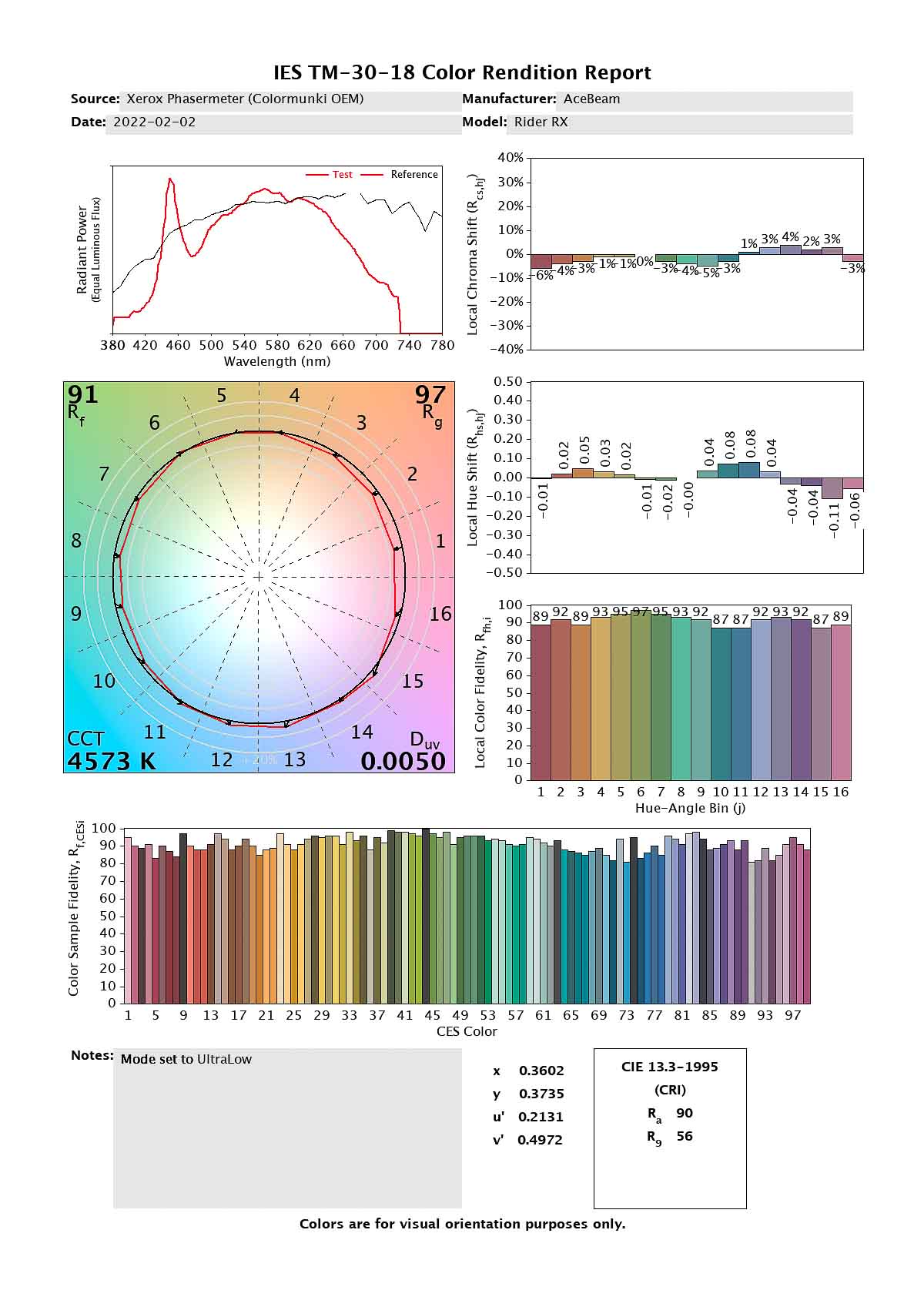
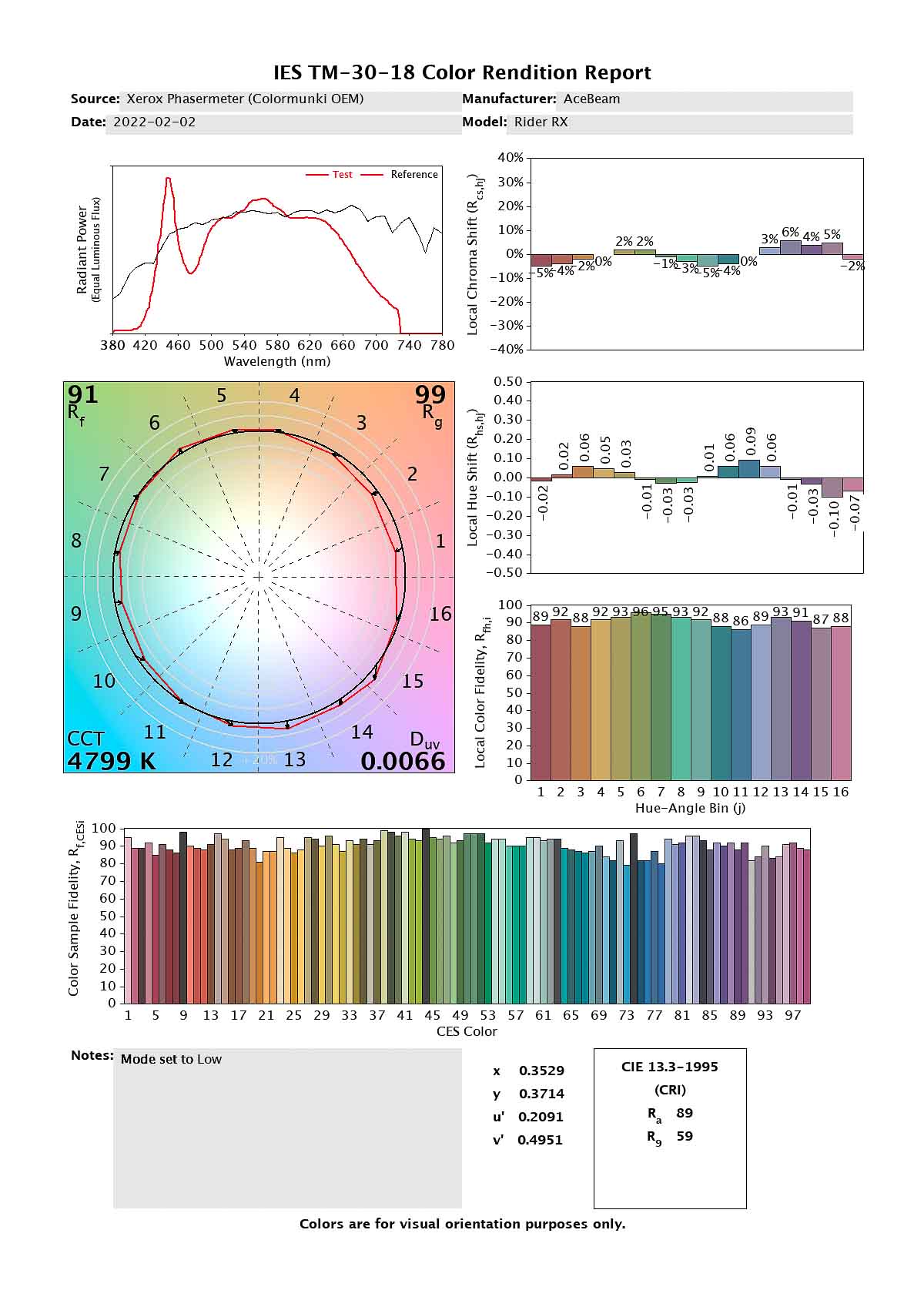
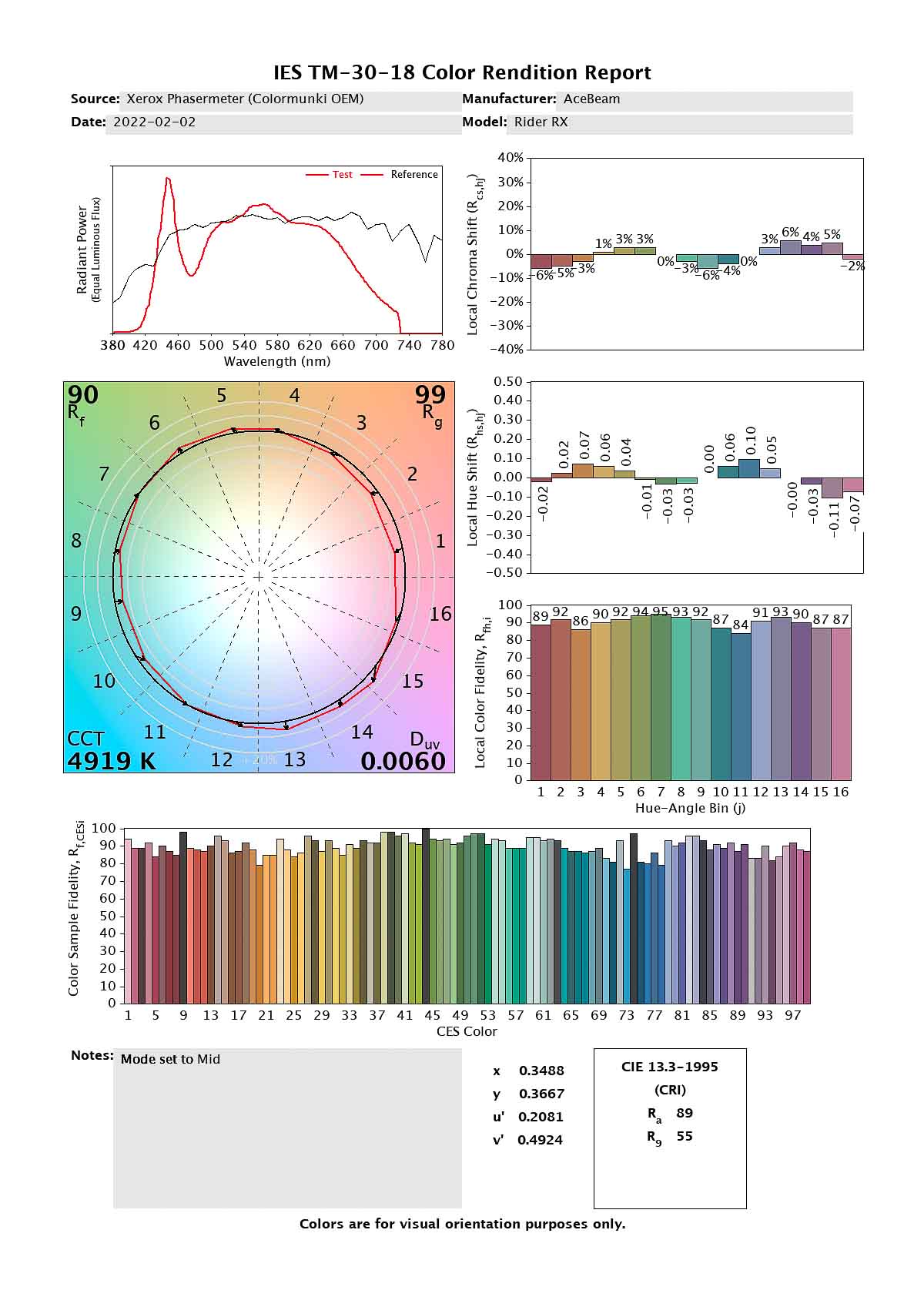

The emitter is slightly above the BBL, so there’s a slightly green tint, but it’s only really an issue when white-wall hunting.
For the emitter-swapping fans out there though – the driver appears to be fairly well in place, with no obvious method to take it out to get at the emitter. But Owen, I hear you say, a 219F 9050 just isn’t sufficient, I need that beautiful 219b 9080! Well… best of luck on that one, but I’m not quite prepared to hack at this. I’m liking it a bit too much to risk breaking it.
ADDENDUM: Well, that was before I killed it. The driver is held in by some glue and the two little “handles” of copper that attach to the threads. Grinding those down, the driver popped right out. I’m still not able to get at the emitter, but I strongly suspect the blue bezel is press-fit down onto the rest of the head. I don’t think this is modifiable without damaging it quite a bit.
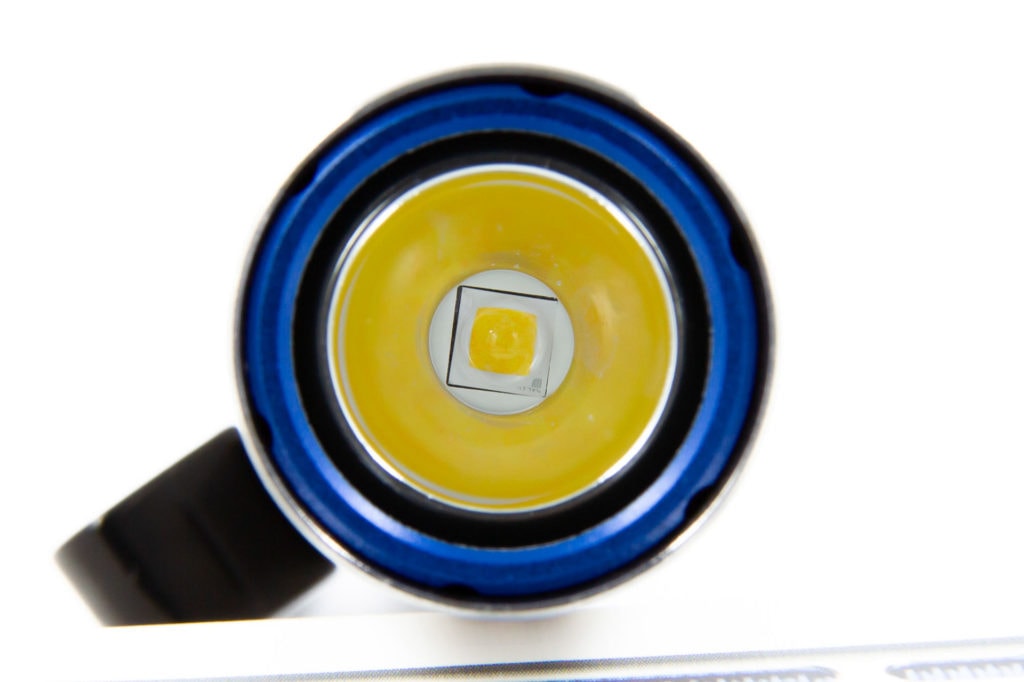
Dimensions and size comparison
- Length: 95.7 mm / 3.77 inches
- Body diameter: 18.6 mm / 0.73 inches
- Diameter at clip: 26.1 mm / 1.03 inches
Weight:
I’m going to do something a little different here, because it’s technically usable in two configurations – with and without the outer shell. I’ll itemise the parts, and then the battery separately, then two configurations.
- Outer shell: 22g / 0.78 oz
- Inner body + clip: 34g / 1.2 oz
- Included Acebeam 14500: 18.4g / 0.65 oz
- Full light + cell: 75.4g / 2.66 oz
- Inner body + cell: 53.4g / 1.89 oz
It’s reported on the site that the light is 82g (2.89 oz) with the cell, but I’m not sure how they got that measurement.
Flashlight comparison
Compared with other 14500/AA lights, and an 18650 light to highlight the size.
Pic 1: Lumintop Tool AA, Acebeam Rider RX, Zebralight SC5w II
Pic 2: Lumintop Antman, Acebeam Rider RX, Lumintop EDC AA
Pic 3: Acebeam Rider RX, Zebralight SC64c LE
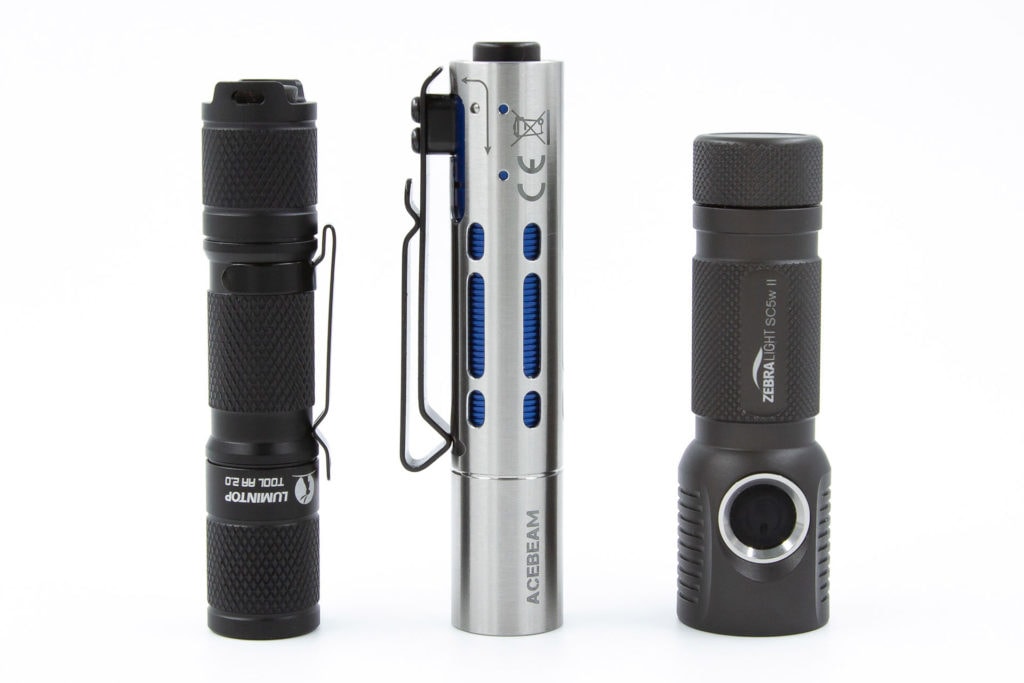
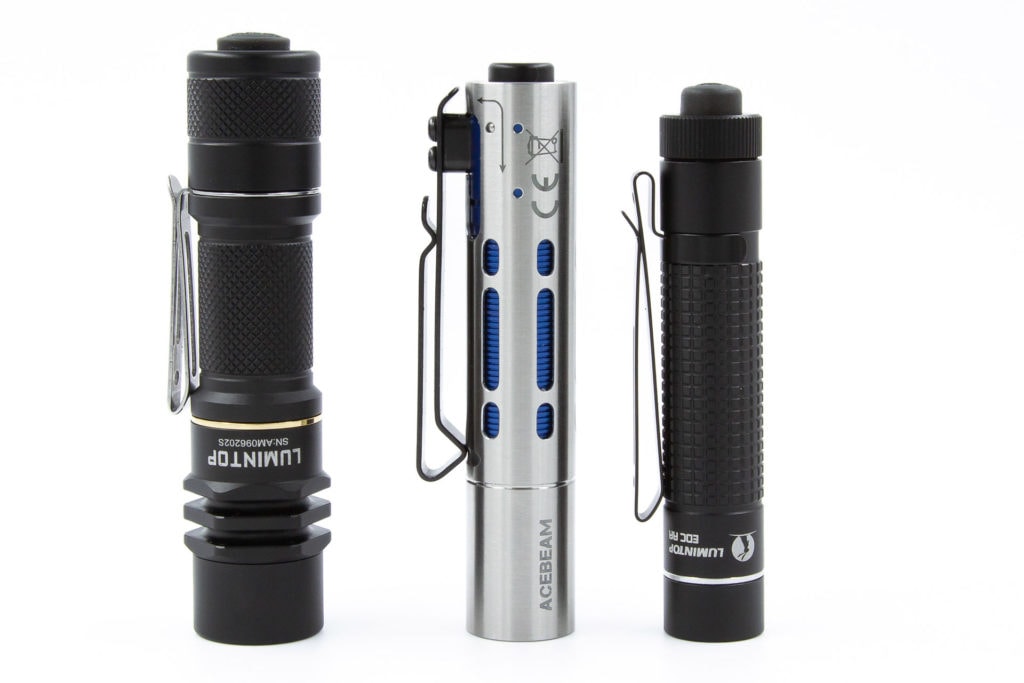
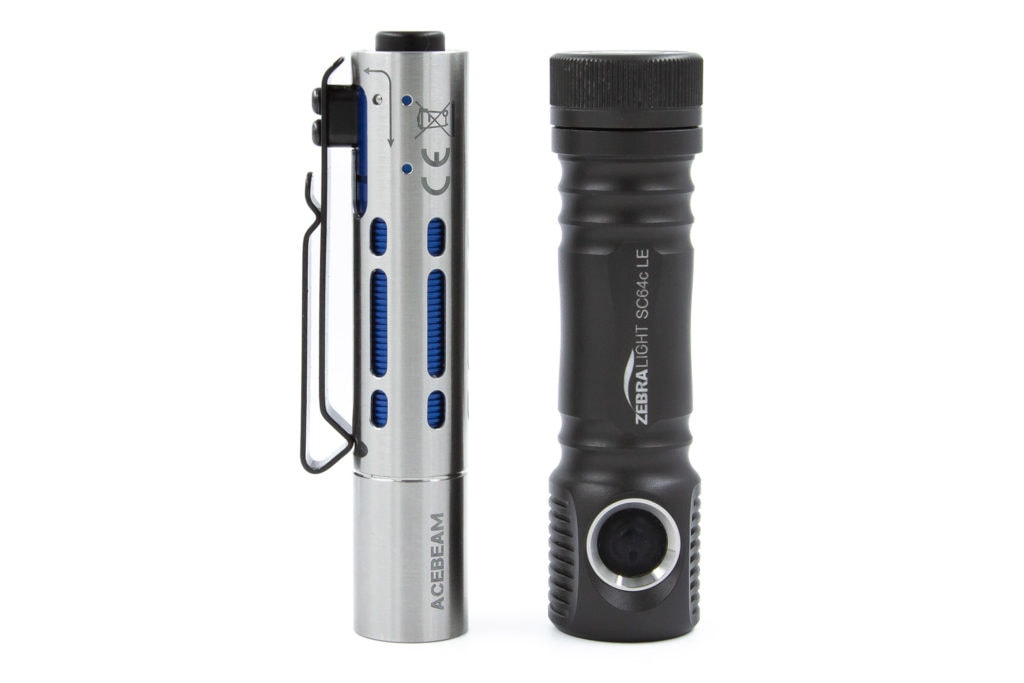
Driver & User Interface:
Because the Rider RX is a forward clicky, mode changes can only be done before fully activating the switch, so you have to dial in the brightness you want before full activation.
Cycling through the modes twice fairly quickly (so 8 half-presses) will then enable SOS mode – this can be held in momentary mode, or fully activate the switch to have it repeat continuously.
In a true emergency situation, the ability to slide the inner body up and tail-stand the light may come in very valuable for signalling aircraft, etc.
Available modes:
From OFF:
- Half-press: Momentary-on (starts in last-used mode, cycles upwards through UL / L / M / H)
- Single click: Turn light on in current mode
From ON:
- Half-press: N/A
- Single click: Turn light off.
Mode memory:
- The light will always turn on (either momentary or full activation) in the last mode you used it in, except SOS.
Low voltage warning:
- The light itself doesn’t seem to have LVP on either Li-Ion or NiMH – but the included 14500 cell will cut out when it’s sufficiently low with its own protection circuit.
Strobe/blinkies
- SOS – cycle through the modes twice, then on the next half-press, SOS will activate.
Lock-out mode:
- No lockout, as the threads on the head are not anodised. The best way to prevent accidental activation is to move the clip so that the switch recesses into the outer sheath.
PWM
- There’s PWM visible by camera, primarily in higher modes, but I can’t detect any by waving paper past the beam, or by shining it at a fan.
Batteries & Charging
The Rider RX can run on both 14500 cells and AA, which is great for giving options to the user. It’s far brighter using a 14500, as expected.
The 14500 cell (920mAh) included has a USB-C port, but can only charge over USB-A to USB-C. I’ve tried a few USB-C chargers, to no avail.
Charging rates:
- USB-A to C: 5V 440mA (2.2W). This works out to around 520mA at 4.2V.
- In Vapcell S4+ on auto: The S4+ selects 1A charging rate – which I think is a little too optimistic (I’d rather keep it to 500mA).
I’ve done a few tests with rechargeable AA cells, but it really limits the 219F’s potential. Unless you’re overflowing with spare AA cells, I’d stick to the 14500.
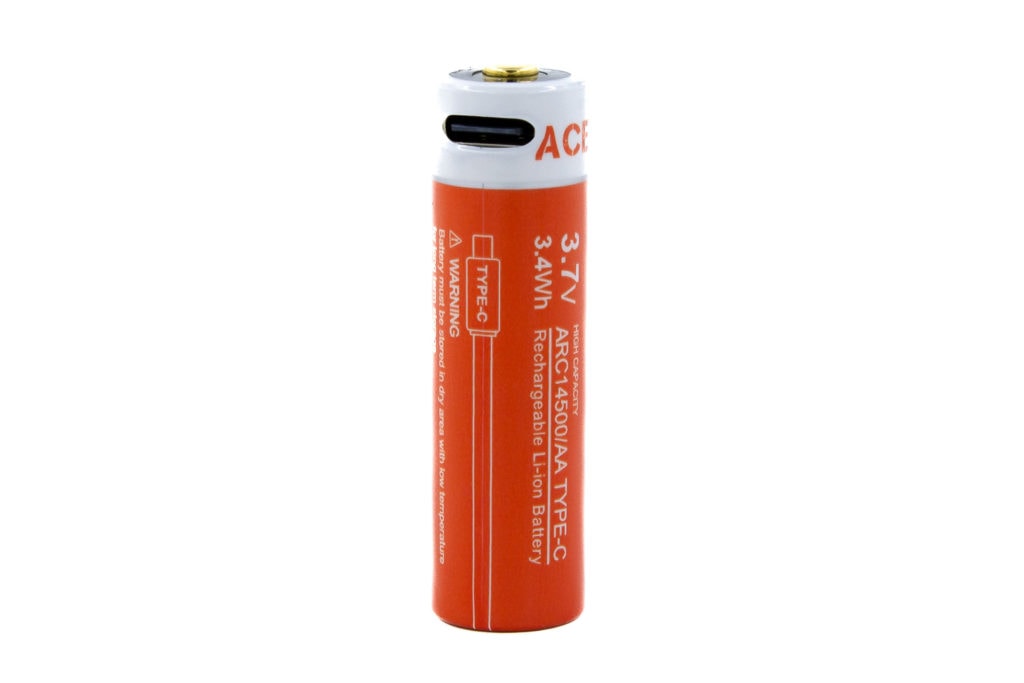
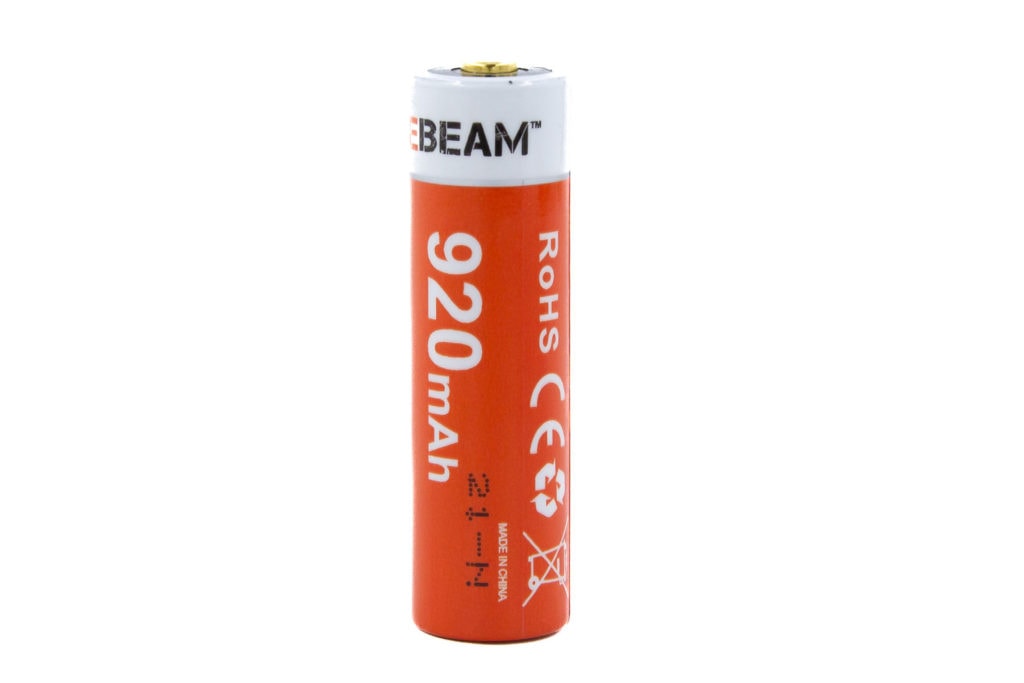
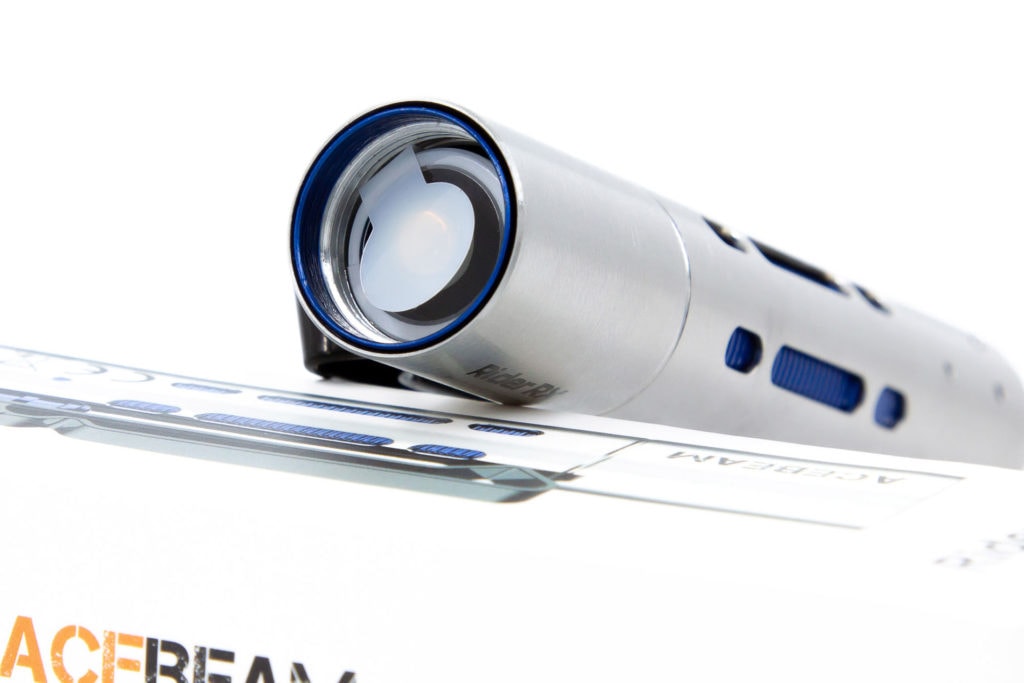
Performance test
For my readings, I use the following:
Lux Meter: For lumen readings and runtimes, an Adafruit TSL2591 connected to a Raspberry Pi running Ubuntu, using RuTiTe by bmengineer in a custom sphere. A UNI-T UT383S is used for candela readings.
DMM: UNI-T UT139C and UNI-T UT210E – 16AWG wire is used directly into the 139C via some banana plugs, and 8AWG wire in a loop for the UNI-T. The DMM I use depends on how high the expected current will be – I use the 139C for <10A, and the 210E for >10A.
Lumen measurements (for each mode)
With the included 14500 cell:
| Mode | Amps at start | Specs | turn on | 30 sec | 10 min |
|---|---|---|---|---|---|
| Ultra-Low | 13mA | 7 lumens | 5 | 5 | 5 |
| Low | 244mA | 70 lumens | 74 | 53 | 52 |
| Mid | 868mA | 280 lumens | 273 | 252 | 230 |
| High | 2.24A | 650 lumens | 610 | 553 | 286 |
Parasitic drain:
- No parasitic drain due to being a mechanical clicky.
Runtime graph
I ran High, Medium, and Low modes with the included 14500 to test for optimal output.

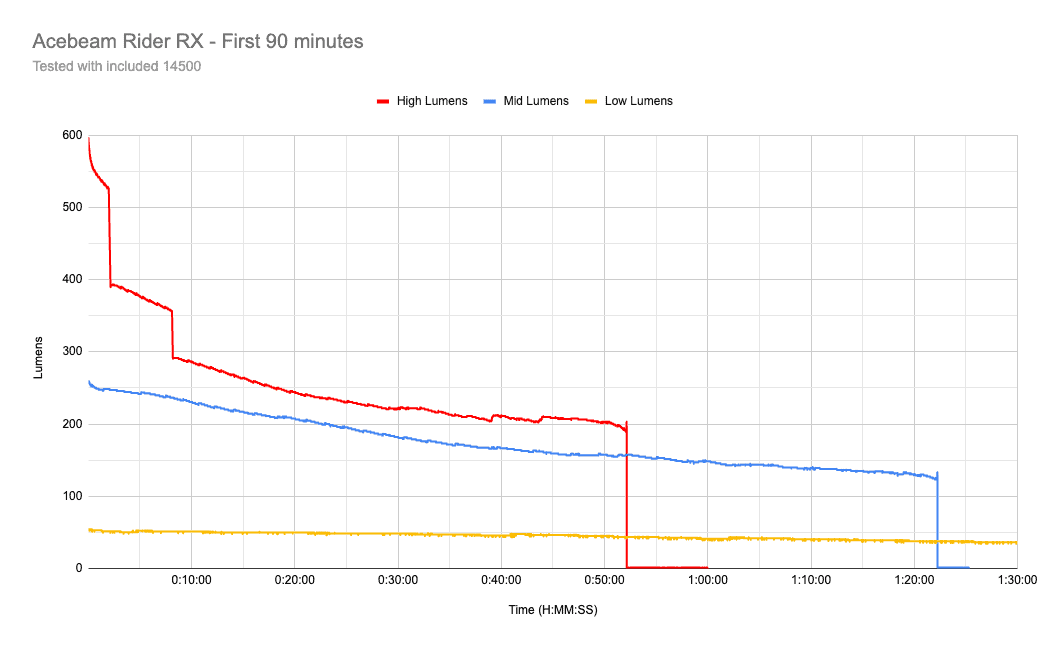
In High, we see the output dropping quite a bit initially, before starting to flatten out, then a sharp drop, slow decline, sharp drop again, then slow decline to off. It’s advertised as 2+6+55 mins in High, and that seems to be slightly more than we got here, with only 52 minutes or so in total (vs 63).
In Medium, the light slowly dims over the course of 82 minutes (advertised as 60, so not too shabby at all).
However, in Low… this is where my mind was blown. It’s advertised as running for 3 hours and 8 minutes, but in my testing, it ran for 12 hours and 44 minutes. Admittedly it started lower than expected, and gradually drifted down to 15 lumens – but in a pitch-black environment, that’s plenty. Very surprised by this, but a happy surprise!
Throw numbers:
Readings were taken at 5 metres for Low, Mid, and High. Each mode is tested three times, waving the hotspot around the sensor gently, and recording the maximum lux value, and then an average is taken.
The only throw figures mentioned are a maximum of 2304cd (96m/315ft/105y).
This is with the included 14500 cell, to show “out of the box” performance. Well, out of the box and then a good charge.
| Mode | Specs | Candela measured | Metres | Yards |
|---|---|---|---|---|
| Low | N/A | 550 | 46.90 | 51 |
| Mid | N/A | 1775 | 84 | 92 |
| High | 2304 cd | 3,600 cd | 120 | 131 |
So – my readings are quite a bit higher than the 96m on the box. I repeated the test again in another location to be sure I wasn’t getting any odd reflections, but it was within 2 lux (144 – 146), so I can only assume that it’s an accurate reading.
Nice!
Beamshots
Taken at 5m from garage door. Annoyingly a neighbour’s security light kept coming on, giving extra light behind it.
Shots taken at 0.3 sec, f6.3, ISO 1600, except for the other lights, where I somehow switched to ISO 400. Hmm.
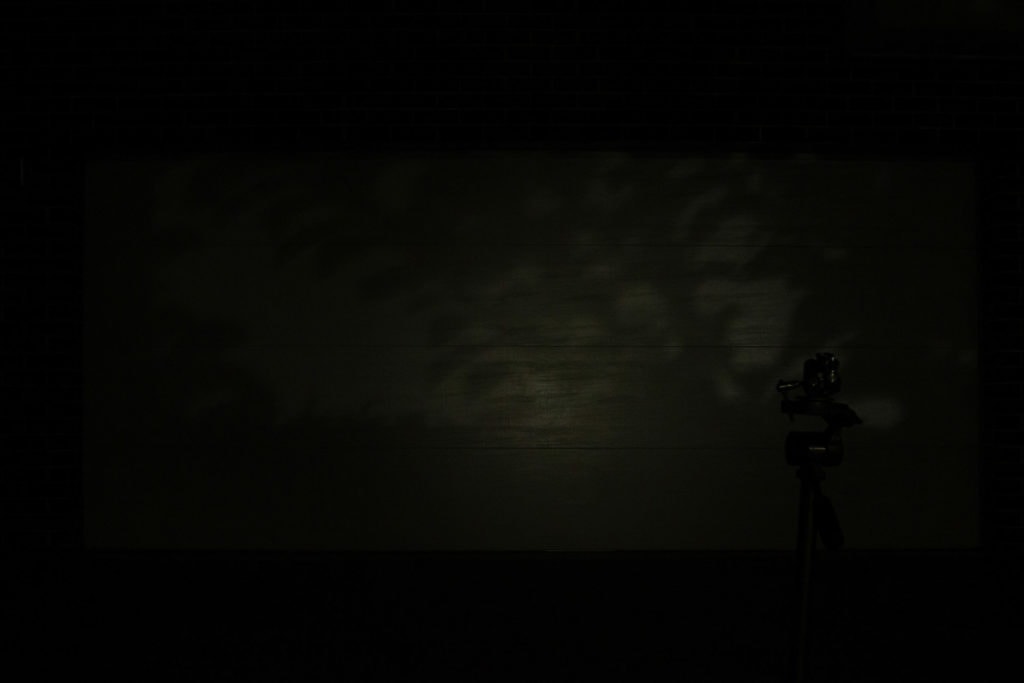
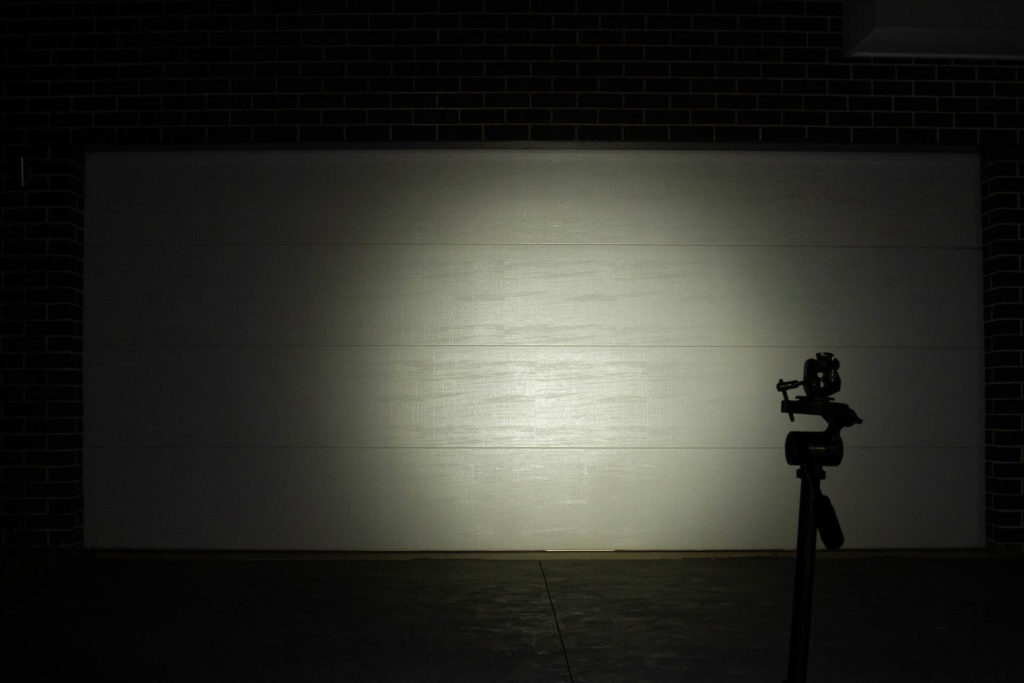
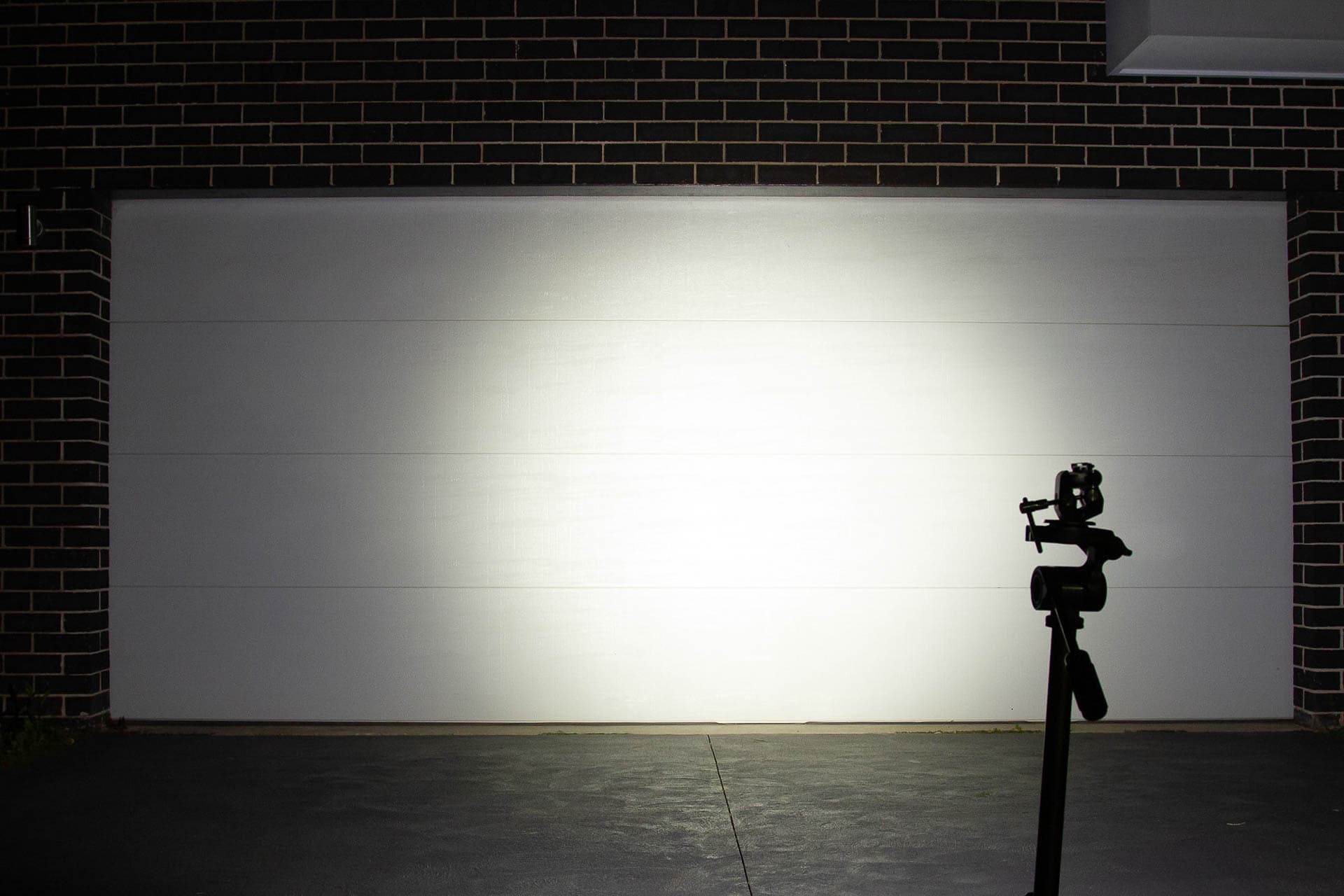
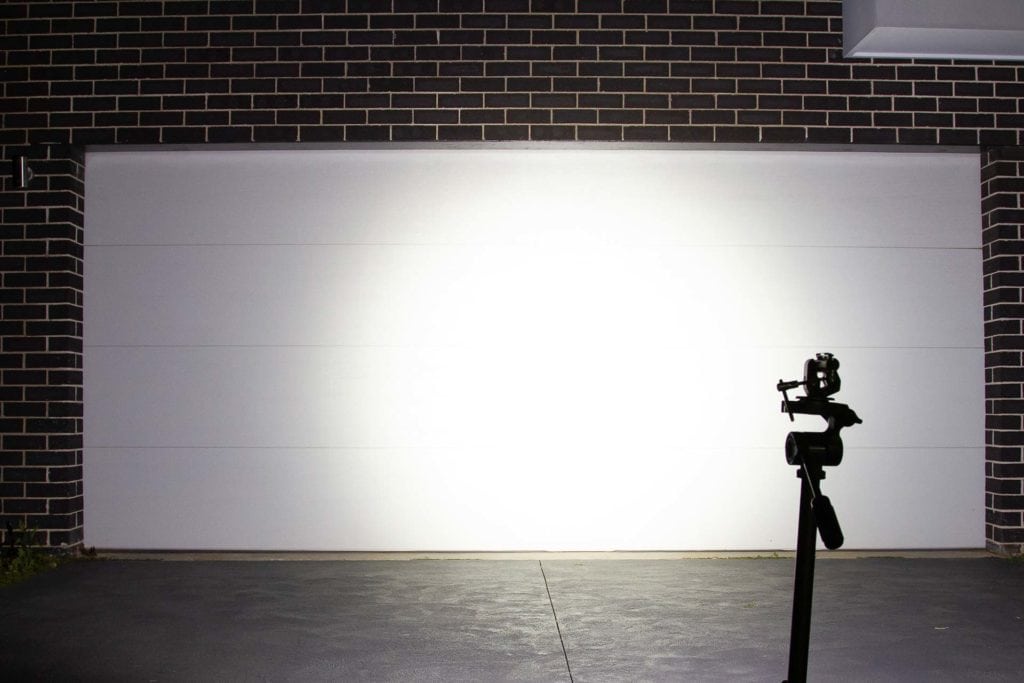
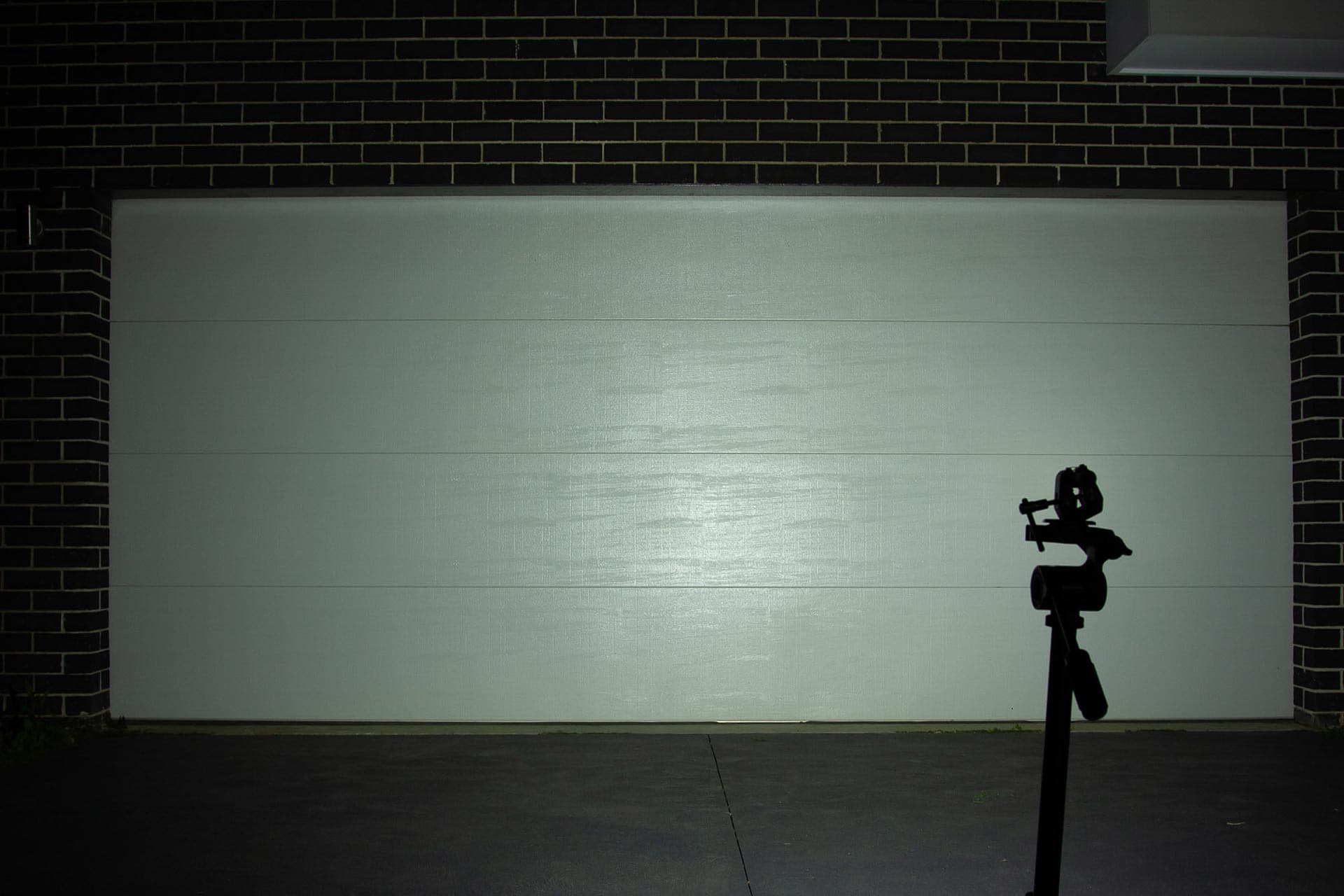
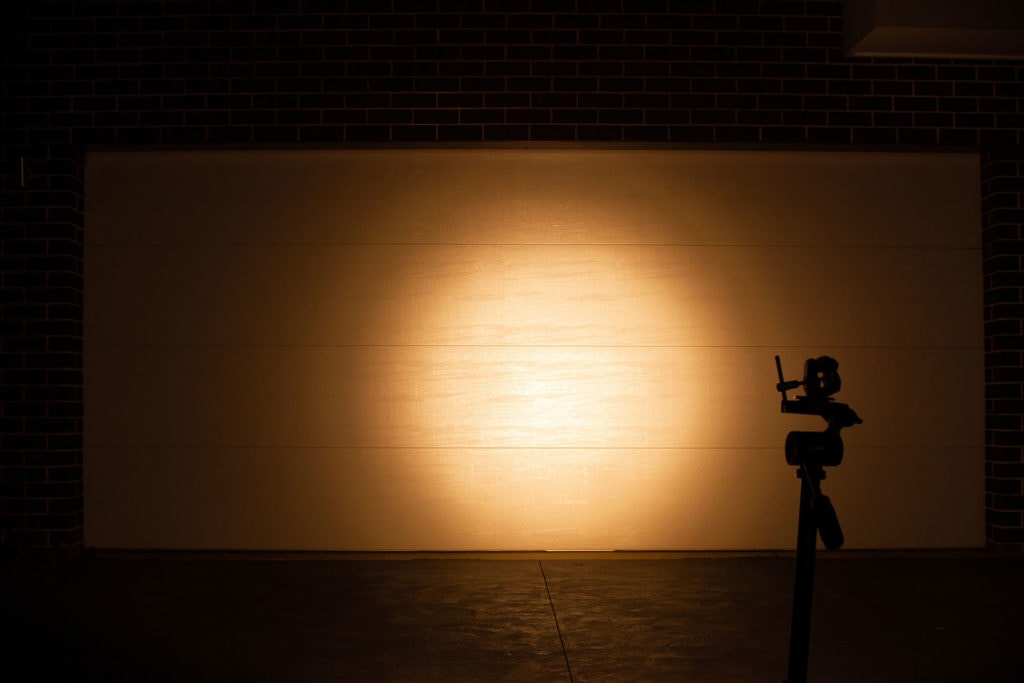
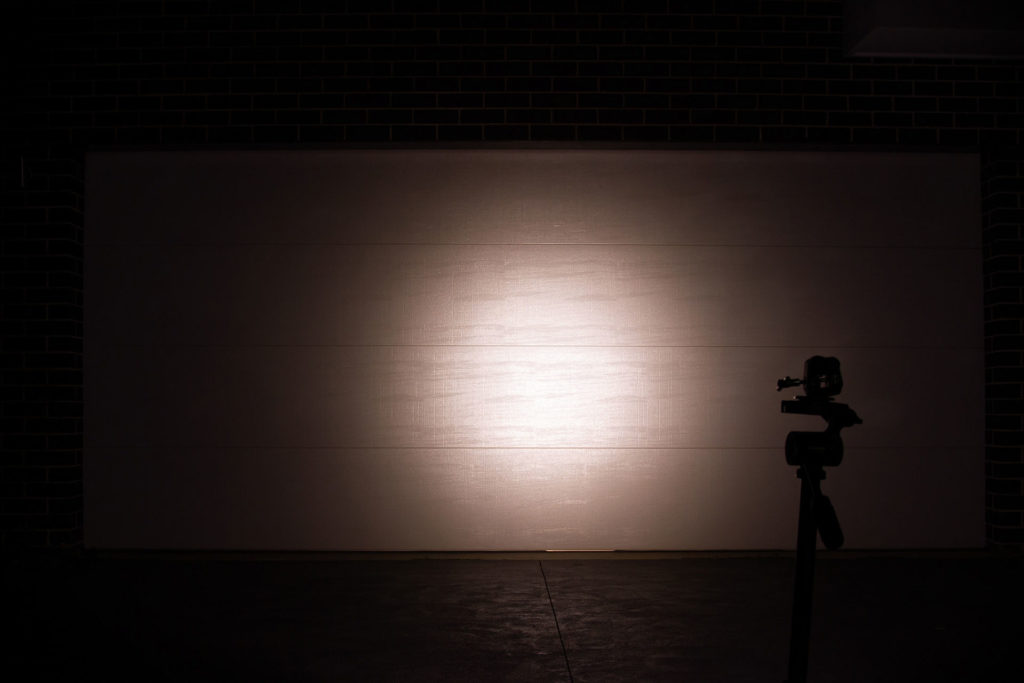
Disclaimer: This flashlight was sent to me for review at no cost by Acebeam. I have not been paid to review, nor have I been holding back on problems or defects.
Final Verdict
Pros
- Very attractive styling
- Good beam profile
- Great to see new emitters
- Fidget clip is great
Cons
- Clip is quite large, compared to light
Explanation on star ratings:
1: Avoid: my phone flashlight would be a better choice – 2: Poor: significant defect or issues; almost unusable – 3: Average: some defects or issues; but still usable 4: Good: recommended (minor issues) – 5: Great: highly recommended

4.5 stars: ★★★★⋆
Oh I like it.
The two-tone of the light is super-sexy, and the beam, while not perfect, is very nice.
It’s a fair bit larger than other 14500 lights, but that’s due to the external stainless shell. Without that, I wouldn’t have the fidget aspect though, so I don’t mind the size increase.
Runtimes are perfectly acceptable for 14500,
The only thing that potentially brings this light down is the price, as I know some will baulk at the $55USD retail price – but there’s a lot of work that’s gone into this light to make it what it is.
I’m very happy to rate the AceBeam Rider RX at 4.5 stars.
Buy your Acebeam Rider RX here
Get a whopping 15% off your next order at Acebeam.com with the following discount coupon: AE15. Simply add the coupon code at your checkout.
1lumen selects and reviews products personally. We may earn affiliate commissions through our links, which help support our testing.